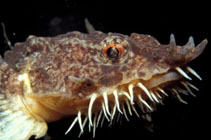| Family: |
Agonidae (Poachers), subfamily: Agoninae |
| Max. size: |
21 cm TL (male/unsexed); max. reported age: 3 years |
| Environment: |
demersal; marine; depth range 0 - 270 m |
| Distribution: |
Northeast Atlantic: English Channel to Finmarken and Murman coasts and White Sea, also the Shetlands, the Faroes and southern and southwestern coasts of Iceland; southern part of Baltic. |
| Diagnosis: |
Dorsal spines (total): 5-6; Dorsal soft rays (total): 6-8; Anal soft rays: 5-7. Unpaired breast row of plates absent, but paired plate rows cover whole breast. Snout with a pair of strong spiny hooks; numerous barbels on branchiostegal membranes. Dorsal plates 31-34 (Ref. 232). Spiny and soft dorsal fins almost fused. No spines on the hind part of the head (Ref. 35388). |
| Biology: |
Inhabits inshore waters, deeper waters in winter in Skaggerak, preferring sandy bottoms, rarely with stones. Maximum depth reported at 270 m (Ref. 28197). Temp. range: 4.0-8.0 °C. Feeds on bottom crustaceans and polychaetes. Matures after about 1 year; a few spawning in the second year (Ref. 722). The eggs are laid in seaweed (Ref. 9900). Spawns in February - April, female laying 2,500-3,000 yellow eggs with a diameter of 2 mm. Period of development is very long and 6-8 mm long pelagic larvae hatch after 10-11 months (Ref. 35388). |
| IUCN Red List Status: |
Least Concern (LC); Date assessed: 18 October 2013 Ref. (130435)
|
| Threat to humans: |
harmless |
Source and more info: www.fishbase.org. For personal, classroom, and other internal use only. Not for publication.

